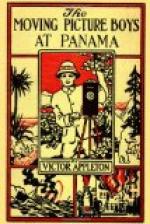The pictures obtained, however, were not very satisfactory. The light was poor, for the jungle was dense there, and the tapirs took fright almost at first, so the resultant film, as Blake and Joe learned later, when it was developed, was hardly worth the trouble they took. Still, it showed one feature of the Panama jungle.
All about the boys was a wonderful and dense forest. There were many beautiful orchids to be seen, hanging from trees as though they really grew, as their name indicates, in the air. Blake and Joe took views of some of the most beautiful. There was one, known as the “Holy Ghost” which only blooms twice a year, and when the petals slowly open there is seen inside them something which resembles a dove.
“Let’s get some pictures of the next native village we come to,” suggested Blake, as they went on after photographing the orchids and the tapirs.
“All right, that ought to go good as showing a type of life here,” Joe agreed. And they made a stop in the next settlement, or “clearing,” as it more properly should be called.
At first the native Indians were timid about posing for their pictures, but the guide of the boys’ party explained, and soon they were as eager as children to be snapped and filmed.
“This is the simple life, all right,” remarked Blake, as they looked at the collection of huts. “Gourds and cocoanut shells for kitchen utensils.”
That was all, really, the black housekeeper had. But she did not seem to feel the need of more. The Panama Indians are very lazy. If one has sufficient land to raise a few beans, plantains and yams, and can catch a few fish, his wants are supplied. He burns some charcoal for fuel, and rests the remainder of the time.
“That is, when he doesn’t go out to get some fresh meat for the table,” explained the guide.
“Meat? Where can he get meat in the jungle, unless he spears a tapir?” asked Blake.
“There’s the iguana,” the guide said, with a laugh.
“Do they eat them?” cried Joe, for several times in the trip through the jungles he had jumped aside at a sight of the big lizards, which are almost as large as cats. They are probably the ugliest creatures in existence, if we except the horned toad and the rhinoceros.
“Eat them! I should say they did!” cried the guide. “Come over here.”
He led the way toward a hut and there the boys saw a most repulsive, and, to them, cruel sight. There were several of the big iguanas, or lizards, with their short legs twisted and crossed over their backs. And, to keep the legs in this position the sharp claw of one foot was thrust through the fleshy part of another foot. The tail of each iguana had been cut off.
“What in the world do they do that for?” asked Blake.
“That’s how they fatten the iguanas,” the guide said. “The natives catch them alive, and to keep them from crawling off they fasten their legs in that manner. And, as the tail isn’t good to eat, they chop that off.”




